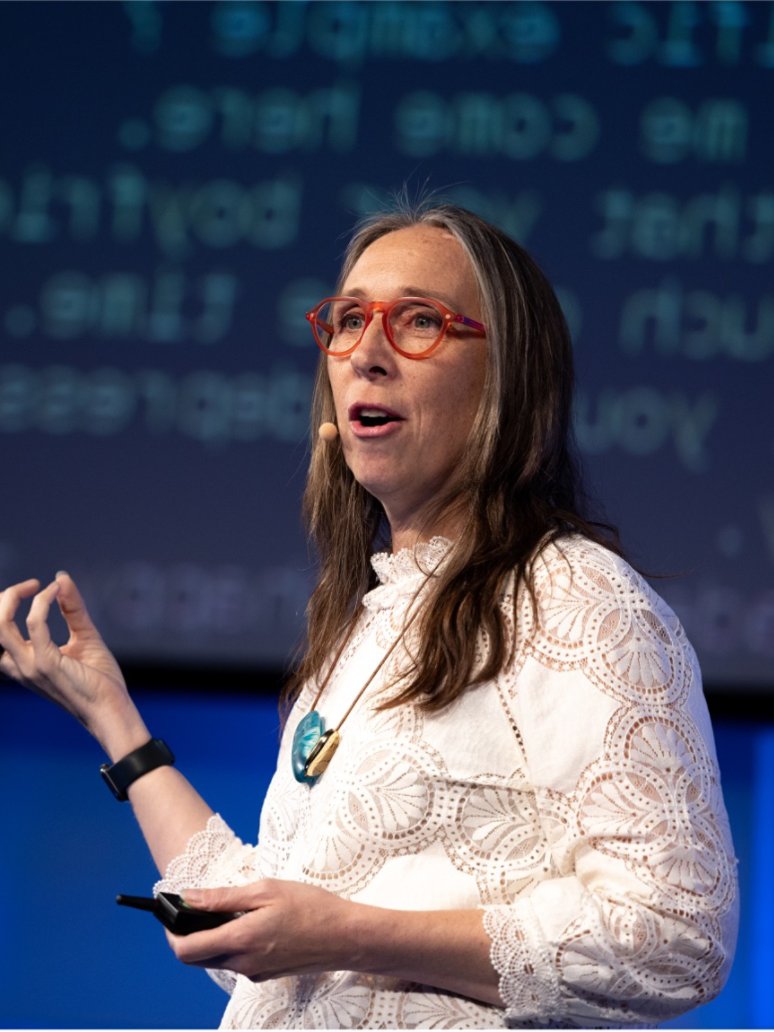
By Sarah B. Nelson, Chief Design Officer and Distinguished Designer, Kyndryl Vital
Are you an arts and humanities person? Or a STEM (science, technology, engineering and mathematics) person? From a young age, a lot of us are told that you can’t be both. It’s an either/or. For me, human-centered design is the converging place where our experiences, business, technology and sustainability all come together. Design empowers interdisciplinary groups to co-create and straddle both worlds.
My dad is an algorithmic generative music composer who uses math and music to create conversations between musicians and machines. Being exposed to that world a young age cast a big influence on me. My first programming language was APL on a terminal connected to a mainframe. As I kid, I coded things like Choose Your Own Adventure stories. One of my favorite projects was a re-creation of Joseph Weizenbaum’s Eliza, a natural language processing computer that simulated a Rogerian psychotherapist. Like a therapist, Eliza probed you with questions, and you responded, which sometimes led to revealing deep emotions and secrets. What excited me about programming Eliza was the interactivity, and the intimate connection with a computer that seemed to really listen.
Eliza taught me that great design is about a connection between people and machines, one that involves conversations. A combination of empathy, curiosity, critical thinking and technical literacy help us create technologies that spark human connection. Take for example, smartphones. Smartphones are all about getting data into our hands when and where we need it. We love these little data machines because they are magical – they let us connect with our loved ones, unlock our creativity, get practical things done, and enables us to travel to both real and imaginative places. All these use cases and applications happen without us knowing about the cloud, data and AI, security, the networks that power it. At its finest, great design hides the technology from us — the product just works.
At Kyndryl, we work with 75% of the Fortune 100 companies, so you can imagine the scale and complexity of problems that these organizations face every day. As the Chief Design Officer for Kyndryl Vital, our designer-led, open and collaborative co-creation experience, we help customers solve their most complicated business challenges with a data-driven approach and ideation techniques.
To create human-centered solutions, the teams at Kyndryl Vital including designers, technical experts and alliance partners, seek outcomes informed by “experience ecosystems.” We want to understand the entire process so we can address issues systematically. We adopt a future-back approach where from defining the problem to concept development, we explore problems iteratively, learning as we go, all while envisioning how our customer’s world will look in the future. It’s the opposite approach most people take, but by working backwards, we can identify and apply technical solutions during the problem-solving process, and most importantly, create innovative, technical solutions that drive maximum impact across businesses, people and our society.
In the fast-paced environments that businesses are expected to operate in today, it’s easy to dive straight into technical solutions as a fast fix. Next time, try our future-back approach — step back and ask, “What challenges are we trying to solve and for whom? Do we have the right people in the room to answer that question?” Know the why and the value to the people the business decisions will impact. Create diverse teams of people with different skill sets, life experiences and points of view. Get curious and talk to your users. Envision that ideal future and work backwards to craft solutions that meet both your business and customer’s needs. Once you have that, then define the technological solution — you might just seize some exciting new opportunities.
Learn more about Kyndryl Vital


